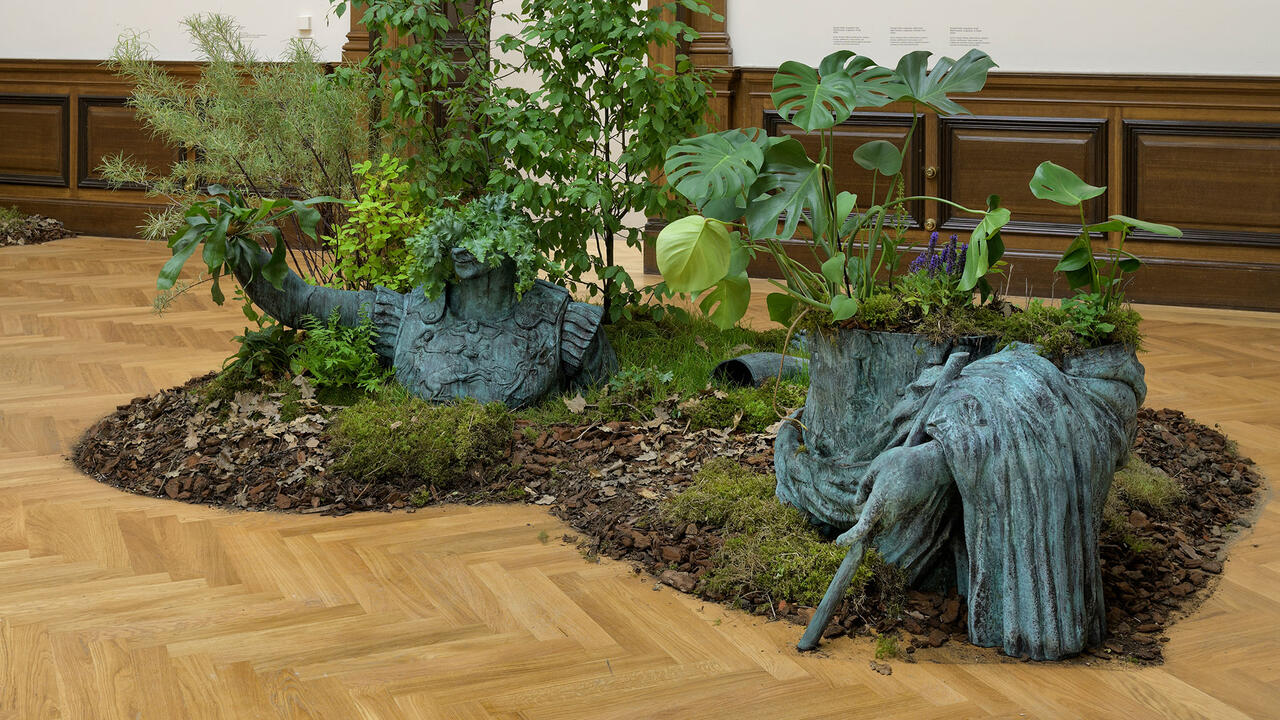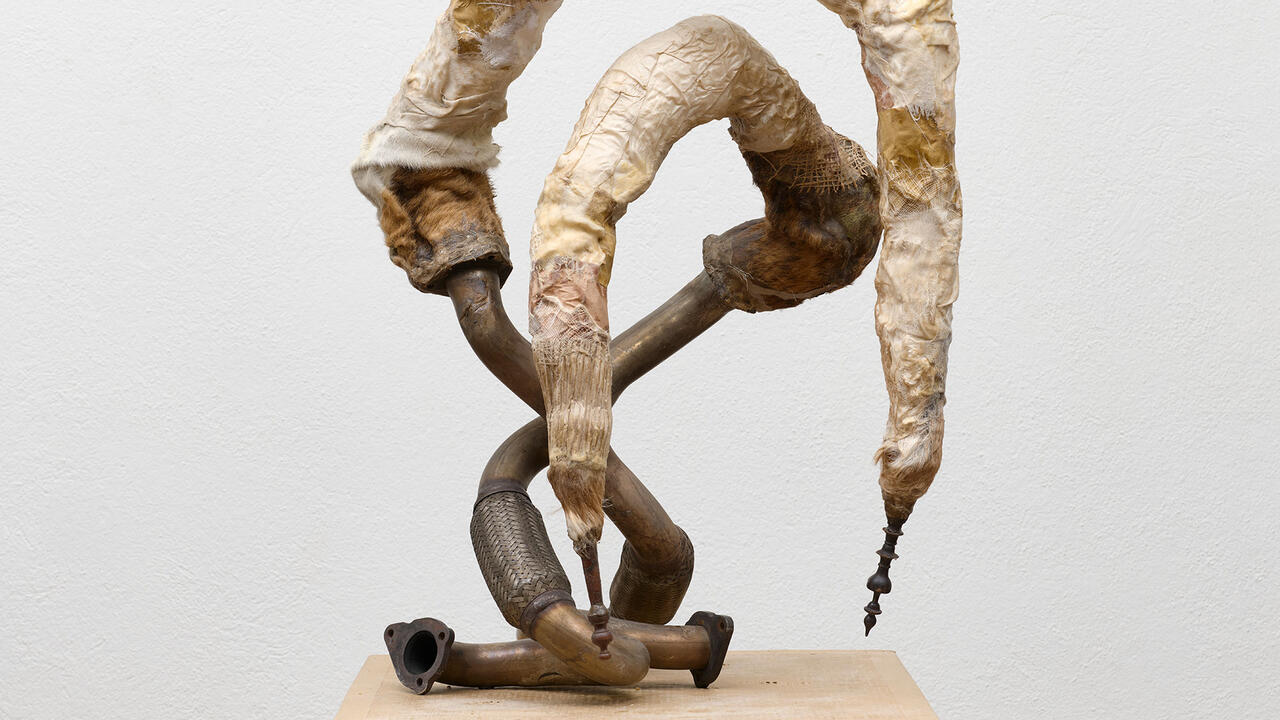Berlin Biennial – Pt. 3
Day three of the Berlin Biennial blog, and I’ve been charged with taking a look around the smaller venues dotted throughout Kreuzberg housing work by Dahn Vo, John Smith, George Kuchar and Cameron Jamie (in the case of Vo, this was taken quite literally, as the site is his own apartment on Kohlfurterstrasse, a short walk from Kottbusser Tor station). These outside venues provide a nice change of pace from the larger ones, particularly Oranienstrasse, where the sheer amount of film makes for a rather relentless viewing experience, especially for those of us only here for a short amount of time.
Along a quiet, unassuming road and up a narrow set of stairs to the top floor of a smallish apartment block, the undiscerning viewer is greeted with little more than a normal, if sparsely furnished flat: an empty bathroom save for a washing machine and floor-to-ceiling white tiling with delicate red, stringy doodles; a seemingly fully furnished kitchen and a study with a large table bearing a letter written in french, and what looked like architectural plans and various other assorted documents. An inkjet print photo stuck on a nearby computer monitor and the neat layout of the documents gives the game away, bringing to mind Simon Fujiwara’s Desk Job (2009) at the Danish Pavilion in Venice last year. Like Fujiwara’s work, these objects are quite clearly related to the artist’s own family history but whilst the context of Fujiwara’s work outs its fantasy status and historical embellishment in the setting of a fictional curator’s modernist apartment, here, the installation of these works in the artist’s own (real!) home on a normal, unassuming street in Kreuzberg takes the conceit to its end point, camouflaging the works amid the debris of Vo’s everyday life.

Up the road and through the bazaar of Turkish kebab houses behind the Kottbuser Tor station to a deserted shop, dark except for a huge LCD screen and a motley assortment of chairs, we find the grimy, grubby sight of Kingsland Road in Dalston, East London in the 1970s in John Smith’s marvellous The Girl Chewing Gum (1976). (I saw this film for the first time at the RCA Curating MFA degree show and was glad to see it again.) Over documentary-style footage of this unremarkable street we hear the artist in the London accent, oh so particular to the Get Carter era, barking out stage directions to pedestrians, cars, pigeons and even buildings, who pleasingly, and quite unknowingly, obey his every command. The ruse is as simple as it is funny.

From one funny chap to another, this time the equally overlooked and even more prolific filmmaker, George Kuchar who has apparently made more than 200 films. I first heard of him when mentioned by Vincent Fecteau in his interview with Bruce Hainley published in our April issue, but this was the first time I had seen any of his films other than a few clips on YouTube. A selection of 15 of his films, chosen by the film curator, Marc Siegel, show diaristic accounts of Kuchar’s day-to-day activity; watching TV taking his aging mother out in her wheelchair, visiting friends on their ranch, his ‘filmscapes’ as he calls them – plotless, themed accounts featuring himself as actor, narrator, director and editor – demonstrate an instinctively sharp eye for editing images that mirror the passage of movement through the narrative highs and lows of day-to-day life as well as a great taste in music that soundtracks the feeling of Americana in his films. These gifts, coupled with his brassy Bronx accent and acerbic wit make for strangely compelling viewing of what is a rare glimpse back into an overlooked body of work.

Around the corner from this trove of American pastoral is the installation by Cameron Jamie, another American artist who is probably best known for documenting the peculiarities of American subcultures in films such as BB (2000) and Spook House (2002). Ushered into a pitch black room in small groups with one of your group given a lantern to hold, through the murk you make out a circle of head-height glazed clay sculptures. Painted in a variety of brilliant colours but hard to make out in the gloom, they look like pebble towers you see outside Buddhist temples and hint at the interest with ritual that runs through his work. In an adjoining back room hang a collection of equally colourful, ghoulishly styled ceramics masks. I suppose the hushed silence of the darkened room, the performative aspect of being led by perhaps someone you have only just met around these objects, the play of colour, light and shadows is meant to create a retreat away from the ‘real’ of the rows of beaten up cars outside the warehouse and the car-repairs workshops but the experience feels like bad immersive theatre – forced, mawkish and dumb.
A disappointing end to an otherwise good day of thoughtful, nuanced work – a refreshing change to some of the didactic fare offered in the main sites.
Back out into the brilliant sunshine that Berlin has enjoyed for the last week and the cheering thought of yet more Kuchar films to discover, as well as a rather dauntingly long list of openings this evening. A round-up of the highlights from these to follow in tomorrow’s blog…
Day three of the Berlin Biennial blog, and I’ve been charged with taking a look around the smaller venues dotted throughout Kreuzberg housing work by Dahn Vo, John Smith, George Kuchar and Cameron Jamie (in the case of Vo, this was taken quite literally, as the site is his own apartment on Kohlfurterstrasse, a short walk from Kottbusser Tor station). These outside venues provide a nice change of pace from the larger ones, particularly Oranienstrasse, where the sheer amount of film makes for a rather relentless viewing experience, especially for those of us only here for a short amount of time.
Along a quiet, unassuming road and up a narrow set of stairs to the top floor of a smallish apartment block, the undiscerning viewer is greeted with little more than a normal, if sparsely furnished flat: an empty bathroom save for a washing machine and floor-to-ceiling white tiling with delicate red, stringy doodles; a seemingly fully furnished kitchen and a study with a large table bearing a letter written in french, and what looked like architectural plans and various other assorted documents. An inkjet print photo stuck on a nearby computer monitor and the neat layout of the documents gives the game away, bringing to mind Simon Fujiwara’s Desk Job (2009) at the Danish Pavilion in Venice last year. Like Fujiwara’s work, these objects are quite clearly related to the artist’s own family history but whilst the context of Fujiwara’s work outs its fantasy status and historical embellishment in the setting of a fictional curator’s modernist apartment, here, the installation of these works in the artist’s own (real!) home on a normal, unassuming street in Kreuzberg takes the conceit to its end point, camouflaging the works amid the debris of Vo’s everyday life.
Up the road and through the bazaar of Turkish kebab houses behind the Kottbuser Tor station to a deserted shop, dark except for a huge LCD screen and a motley assortment of chairs, we find the grimy, grubby sight of Kingsland Road in Dalston, East London in the 1970s in John Smith’s marvellous The Girl Chewing Gum (1976). (I saw this film for the first time at the RCA Curating MFA degree show and was glad to see it again.) Over documentary-style footage of this unremarkable street we hear the artist in the London accent, oh so particular to the Get Carter era, barking out stage directions to pedestrians, cars, pigeons and even buildings, who pleasingly, and quite unknowingly, obey his every command. The ruse is as simple as it is funny.

From one funny chap to another, this time the equally overlooked and even more prolific filmmaker, George Kuchar who has apparently made more than 200 films. I first heard of him when mentioned by Vincent Fecteau in his interview with Bruce Hainley published in our April issue, but this was the first time I had seen any of his films other than a few clips on YouTube. A selection of 15 of his films, chosen by the film curator, Marc Siegel, show diaristic accounts of Kuchar’s day-to-day activity; watching TV taking his aging mother out in her wheelchair, visiting friends on their ranch, his ‘filmscapes’ as he calls them – plotless, themed accounts featuring himself as actor, narrator, director and editor – demonstrate an instinctively sharp eye for editing images that mirror the passage of movement through the narrative highs and lows of day-to-day life as well as a great taste in music that soundtracks the feeling of Americana in his films. These gifts, coupled with his brassy Bronx accent and acerbic wit make for strangely compelling viewing of what is a rare glimpse back into an overlooked body of work.

Around the corner from this trove of American pastoral is the installation by Cameron Jamie, another American artist who is probably best known for documenting the peculiarities of American subcultures in films such as BB (2000) and Spook House (2002). Ushered into a pitch black room in small groups with one of your group given a lantern to hold, through the murk you make out a circle of head-height glazed clay sculptures. Painted in a variety of brilliant colours but hard to make out in the gloom, they look like pebble towers you see outside Buddhist temples and hint at the interest with ritual that runs through his work. In an adjoining back room hang a collection of equally colourful, ghoulishly styled ceramics masks. I suppose the hushed silence of the darkened room, the performative aspect of being led by perhaps someone you have only just met around these objects, the play of colour, light and shadows is meant to create a retreat away from the ‘real’ of the rows of beaten up cars outside the warehouse and the car-repairs workshops but the experience feels like bad immersive theatre – forced, mawkish and dumb.
A disappointing end to an otherwise good day of thoughtful, nuanced work – a refreshing change to some of the didactic fare offered in the main sites.
Back out into the brilliant sunshine that Berlin has enjoyed for the last week and the cheering thought of yet more Kuchar films to discover, as well as a rather dauntingly long list of openings this evening. A round-up of the highlights from these to follow in tomorrow’s blog…














